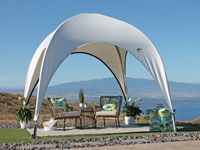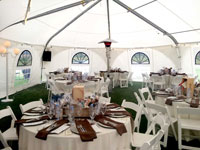Designing facilities to accommodate personnel for research and lodging in the brutal conditions of the Arctic and Antarctic presents some unique challenges. Frigid cold, ever-piling snow drifts, and violently powerful winds are just a few of the more obvious obstacles. These challenges, however, must be overcome to properly study and advance ecology, climatology, geomorphology, glaciology, biogeochemistry, and more.
2018 is set to be a busy year right off the bat with the 5th International Symposium on Arctic Research in mid-January, which is followed by a series of polar and alpine meetings that stretch throughout the year.
These symposiums and meetings will present new solutions to the challenge of research in the Arctic and Antarctic, but there are already some important advancements in building and technology to highlight.
Permanent Solutions
By large, answers to how to accommodate for this inhospitable environment have come down to making structures rugged enough to endure, which requires a degree of permanence. The following Arctic research stations have gone beyond strength with their facilities, presenting some creative and interesting solutions for protecting and lodging personnel, their equipment and data.
Halley VI Research Station
Since January 15th, 1956, the Halley VI station was one of the first internationally significant platform built in a climate-sensitive zone with the intent and design for global earth, atmospheric, and space weather observation. It was at this base in 1985 that the ozone layer hole was discovered.
The 6th iteration of the Halley Research Station is regularly updated and even has hydraulic legs outfitted with skis, meaning it can be moved from location to location. The base itself is divided up into eight modules that can all be lifted or lowered via the hydraulic legs below. This mobility is essential for overcoming a unique challenge placed on this research station; it is located on the Brunt Ice Shelf, which is constantly moving into the Weddell Sea, in addition to its irregular tide induced movement.
Princess Elisabeth Research Station
The world’s first “zero emission” scientific research station is in Antarctica, due south from South Africa. This is an especially profound achievement, considering the station’s vast research that informs worldwide efforts to protect the environment and mitigate ongoing damage that affects us all.
The zero emissions status is accomplished primarily through integration of four different technologies; a passive building design that minimizes energy demand while maximizing solar gain, the use of renewable energies such as the 24-hour long daylight at times of the year and harnessing the brutal arctic winds for power, an intelligently designed “smart grid” that is documented as being three times more efficient than the most effective conventional energy network, and a water treatment plant that was inspired by the international space station.
The design combined all of these facets in order to make the Princess Elisabeth research station virtually autonomous.
Bharati Research Station
India’s third Antarctic station was commissioned in 2012, and made out of 136 prefab containers. Built to mitigate the structures carbon footprint, each container is wrapped in an aluminum casing that serves as insulation against the cold and wind.
Bharati’s design is a result of the Antarctic Treaty System, which means it was designed so that it might later be disassembled and removed from its deployment site without leaving any trace of having been there.
Jang Bogo Station
Korea’s contribution to polar research has engaged the collaboration of Australia, Italy, Russia, New Zealand, and the United States under the target goal to “enhance scientific capabilities of Korea and promote collaboration with other Parties by installing a new station in the Antarctic.”
It opened for operation in 2014. Jang Bogo Research Station is designed to shelter 16 people during the harsh winters, and 60 in the summer. It endures deadly cold temperatures of -31 degrees Fahrenheit (-35 degrees Celsius), and beatings from winds that exceed 100 miles per hour (160.9 kph).
Means that Compliment Goals
The goal of any advancement is progress, although what ‘progress’ means depends on the subject. In the case of polar research it is not about knowledge for its own intrinsic value — as interesting as it may be — but for the betterment of quality of life, ability to perform important research, and the protection of the environment which we depend upon for our lives. A better understanding of all aspects of our environment is needed to more effectively maintain it, the same way a better understanding of how a car works is essential for for a mechanic to make repairs and prevent or /mitigate future damage.
The above examples showcase the commitment of national and international efforts to study and understand the environment. Their work to understand how to protect the environment is done in a way that does not itself create more damage to the environment as it is studied.
This means that research facility and polar research accommodation designs are created with conservation in mind, are they are energy efficient, minimize waste in every possible way, and actively work to do as little as possible that would affect the environment under study.
Research Facilities and Field Camps
There are plenty of polar research expeditions that are only seasonal, or research stations which require structures that can be set up in a fraction of the time compared to conventional permanent construction, as well as the ability to easily take down and move structures.
The United States National Science Foundation goes into the details of what types of field camps are established for these situations, and the types of temporary and semi-permanent structures that are used for housing at these research camps.
Huts: Used for summer research camps and projects that extend into several seasons, huts are erected. These buildings need to be rugged enough to last up to a few years, provide a stable and reliable working environment, and a measure of comfort that just isn’t available in tents.
Tents: Tents are used by smaller research parties that need temporary shelters. They must be stable in high winds, and must be able to be erected and torn down quickly. These usually single or double wall ruggedized versions of camping tents
Modular Buildings: Some research facilities require more widespread building systems that house different departments such as testing labs, computer rooms, community areas and the like. Ideally, different necessary buildings can link together so that researchers do not need to go out into the harsh environment as they move between stations.
Polar Research Camps And Research Facilities from Alaska Structures
Tensioned and engineered fabric buildings can be set up as quickly, and in some cases, faster than the traditional research huts or tents described above, and can be used for both temporary and permanent or more long-term research needs. They also have the capacity to be quickly relocated, and once setup are virtually maintenance free. Alaska Structures is a clear winner for catering to needs of polar research camps, facilities, and living shelters from the extreme elements. Being from Alaska, and having 40 years of proven designs and engineering expertise, they produce a state-of-the-art fabric structures with unmatched capabilities, without sacrificing any green initiatives. Their fabric structures are adaptable to new construction or expansion needs, while maintaining top quality and security.
Most designs can be fitted with an Environmental Control Unit that doubles as providing the ideal climate desired and optimizing energy consumption – thus striking an intrinsic balance between necessity and sustainability in its function and design.
Some of the materials included our structures can even earn LEED points if the effort is a private venture, helping achieve a LEED certification. These highly engineered tensioned fabric structures are produced using lean manufacturing techniques, in strict accordance with the highest quality controls and standards. The high strength frames are made of galvanized steel or lightweight and aircraft-grade aluminum. Powder coating is available for both frame options for extra protection against corrosion. The architectural membranes are PVC-based, made using a proprietary blend of materials to produce a fabric system that offers a greater abrasion resistance, will not rot, is mold and mildew resistant, is UV stabilized for extreme amounts of solar radiation, offers superior protection in temperatures as low as -80˚F to +130˚F, and exceeds the fire safety requirements outlined in the California Code of Regulations (CCR) for membrane structures.. Typical lifespan of our membrane systems is 15-20 years.
Fabric structures from Alaska Structures can be custom designed with a myriad of options including: window, door, lighting and electrical systems, insulation packages, skid-mounted or raised flooring systems, as well as bright exterior colors or patterns for additional safety in snow, blizzard, or near white-out conditions.
Reduce energy usage by incorporating skylight material into the design of your research camp or facilities.
Fabric buildings and camp systems from Alaska Structures are excellent choice for efficiency, portability, customization, and contribute to environmentally sustainable research efforts.
To speak with one of our building specialists about an Alaska Structures building or research camp, call +1-907-344-1565, email us, or contact us online.
[Related: Eco-Friendly And Energy-Efficient Fabric Buildings]

















































































Leave a Reply